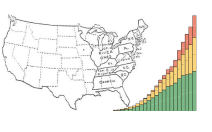The labor force concept used in recent censuses of population dates from the 1930s and includes both persons who are employed (full time or part time) and persons who are unemployed (defined as persons who are not employed but who are actively looking for employment). In censuses prior to 1940, terms like “gainful workers” or “persons with gainful employment” were used with regard to persons who reported an occupation or industry. (See chapters 16 and 17 concerning data on occupation and industry.) Data on unemployment were collected from 1880 to 1910 and in 1930, but these data are not comparable to data on unemployment collected subsequently. For a detailed discussion of the labor force concept and historical labor force trends in the United States, see Susan B. Carter (2006), “Labor Force,” in Historical Statistics of the United States: Millennial Edition, Vol. 2, pp. 2-13 to 2-35.
Estimates of the workforce of the United States for the 1800 to 1900 period are shown in Figure 15-1. These estimates are from Thomas Weiss (2006), “Workforce,” in Historical Statistics of the United States: Millennial Edition, Vol. 2, pp. 2-63 to 2-66. The term workforce corresponds to gainful workers who reported an occupation (1850 to 1900) or industry (1820 and 1840), regardless of their employment status (employed or not employed). For years with no occupation or industry data (1800, 1810, and 1830), workforce data were estimated using estimated participation rates in the workforce.
Labor force estimates up to 1990, shown in Figures 15-2 through 15-5, are from Matthew Sobek (2006b), tables on labor force, in Historical Statistics of the United States: Millennial Edition, Vol. 2, pp. 2-77 to 2-82, and are base on the Integrated Public Use Microdata Series (IPUMS). (See Minnesota Population Center, no date, “IPUMS-USA, Frequently Asked Questions (FAQ)”) Census data for 2000 are not totally comparable with data for 1990 due to changes in editing procedures which led to slightly lower labor force participation rates in 2000 than the 1990 editing procedures would have yielded. See Sandra Luckett Clark et al (2003), “Comparing Employment, Income, and Poverty: Census 2000 and the Current Population Survey,” U.S. Census Bureau, Census 2000 Auxiliary Report. In addition, the 2010 American Community Survey data on labor force are not totally comparable with 2000 census data. For a consistent set of labor force participation rates for 1990, 2000, and 2010 (from the Current Population Survey) see Mitra Toossi (2012), “Labor Force Projections to 2020: a More Slowly Growing Workforce,” U.S. Bureau of Labor Force Statistics, Monthly Labor Review, Vol.135, No. 1 (Jan. 2012), pp. 43-64.
Figures
15-1. Workforce for the Population 16 Years and Over by Sex for the United States: 1800 to 1900
15-2. Labor Force for the Population 16 Years and Over by Sex for the United States: 1860 to 2010
